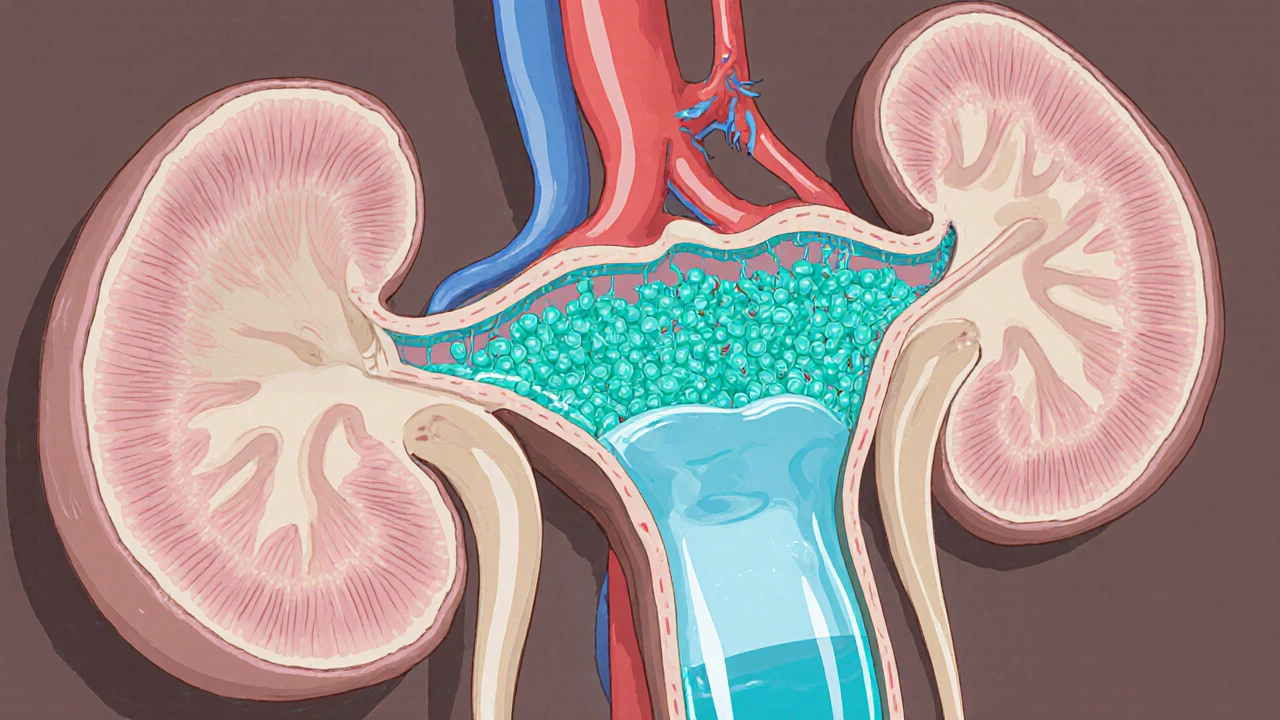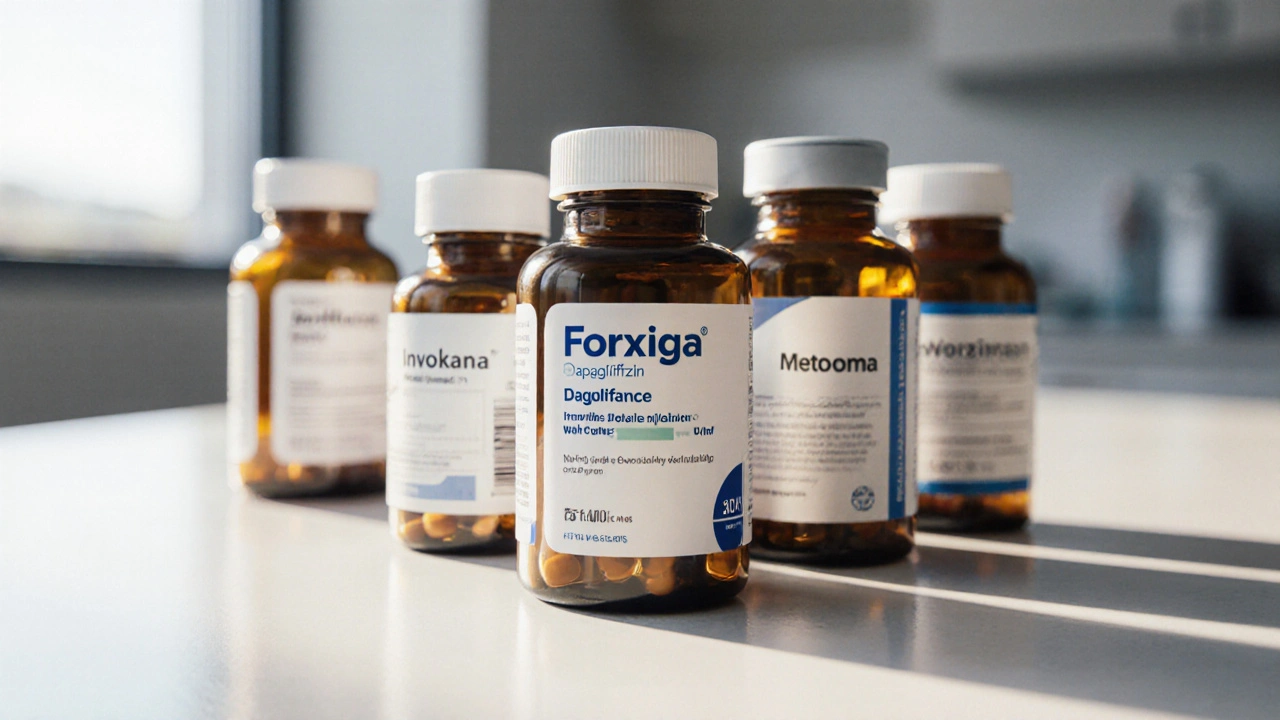Diabetes Drug Comparison Tool
Personalized Diabetes Medication Comparison
Your Personalized Recommendation
Recommended Options
Based on your inputs, these medications align best with your health profile.
Key Comparison
Your physician can provide personalized guidance based on your complete health history.
If you’re weighing Forxiga against other options, this guide breaks it down.
Quick Takeaways
- Forxiga is an SGLT2 inhibitor that lowers blood sugar by forcing glucose out of the urine.
- Its main rivals - Jardiance, Invokana, Metformin, and Ozempic - differ in mechanism, weight impact, and heart benefits.
- Choose Forxiga when you want modest weight loss, low risk of hypoglycemia, and proven cardiovascular protection.
- Consider GLP‑1 agonists like Ozempic if aggressive weight loss or stronger HbA1c reduction is needed.
- Always match the drug to your kidney function, side‑effect tolerance, and overall health goals.
What Is Forxiga (Dapagliflozin)?
Forxiga is the brand name for dapagliflozin, a prescription medication used primarily to improve glycemic control in adults with type 2 diabetes mellitus. Approved by the FDA in 2014, it belongs to the SGLT2 inhibitor class, which works by blocking the sodium‑glucose co‑transporter‑2 in the kidneys, allowing excess glucose to be excreted in urine.
The drug also carries FDA‑approved labels for heart failure reduction and chronic kidney disease progression slowing, making it a multi‑benefit option.
How SGLT2 Inhibitors Differ From Other Diabetes Classes
The SGLT2 inhibitor class includes Forxiga, Jardiance, and Invokana. Their hallmark is a glucose‑lowering effect that is independent of insulin, which reduces hypoglycemia risk when used alone.
In contrast, Metformin (a biguanide) decreases hepatic glucose production and improves insulin sensitivity, while Semaglutide - sold as Ozempic - is a GLP‑1 receptor agonist that mimics the incretin hormone to boost insulin secretion and curb appetite.

Key Alternatives to Forxiga
Below are the most frequently compared drugs.
- Jardiance (empagliflozin) - another SGLT2 inhibitor with strong cardiovascular outcome data.
- Invokana (canagliflozin) - SGLT2 inhibitor noted for a slightly higher HbA1c reduction but a boxed warning for amputation risk.
- Metformin - the first‑line oral agent for most people with type 2 diabetes, inexpensive and well‑studied.
- Ozempic (semaglutide) - a weekly GLP‑1 receptor agonist prized for significant weight loss and cardiovascular benefit.
Side‑by‑Side Comparison
| Drug (Brand) | Mechanism | Typical HbA1c ↓ (points) | Weight Effect | Cardiovascular Benefit | FDA Approval Year | Common Side Effects |
|---|---|---|---|---|---|---|
| Forxiga (dapagliflozin) | SGLT2 inhibition - urinary glucose excretion | 0.5‑0.7 | -1 to -2kg | Reduced CV death & HF hospitalisation | 2014 | UTI, genital mycotic infection, dehydration |
| Jardiance (empagliflozin) | SGLT2 inhibition | 0.5‑0.8 | -1 to -3kg | Strong CV mortality reduction | 2014 | UTI, genital infection, ketoacidosis (rare) |
| Invokana (canagliflozin) | SGLT2 inhibition | 0.6‑0.9 | -2 to -4kg | CV benefit, renal protection | 2013 | UTI, genital infection, increased amputation risk |
| Metformin | Decreases hepatic gluconeogenesis, improves insulin sensitivity | 0.8‑1.5 | Weight neutral | No direct CV outcome benefit, but neutral | 1995 (US) | GI upset, B12 deficiency, lactic acidosis (rare) |
| Ozempic (semaglutide) | GLP‑1 receptor agonist - enhances insulin, slows gastric emptying | 1.0‑1.5 | -5 to -10kg | Significant CV event reduction | 2017 | Nausea, vomiting, pancreatitis (rare) |
When Forxiga Is the Right Pick
Pick Forxiga if you meet these conditions:
- eGFR is ≥45mL/min/1.73m² (kidney function is adequate for SGLT2 drugs).
- You want modest weight loss without injecting a medication.
- Reducing heart‑failure hospitalisations is a priority (e.g., existing HFrEF).
- Low risk of genital infections - for example, you’re not prone to recurrent UTIs.
Patients who are already on metformin and need an additional oral agent often add Forxiga before moving to injectable GLP‑1 therapies.

Scenarios Where Alternatives Might Edge Out Forxiga
Jardiance shines when the primary goal is maximal cardiovascular mortality reduction; its trial (EMPA‑REG) showed a 38% drop in CV death.
Invokana may be chosen for stronger HbA1c lowering, but only if the patient has no history of peripheral artery disease because of the amputation warning.
Metformin stays first‑line for nearly all newly diagnosed patients because it’s cheap, has a long safety record, and improves insulin sensitivity.
Ozempic is the go‑to for those who need powerful weight loss or struggle with glycemic control despite two oral agents; the injection route is a barrier for some, but the weekly dose is convenient.
Practical Checklist for Choosing a Therapy
- Assess kidney function (eGFR). If <45, avoid SGLT2 inhibitors.
- Identify cardiovascular or renal comorbidities. Prioritize drugs with proven outcome data.
- Consider patient preference: oral vs injection, frequency, cost.
- Review side‑effect profile - especially risk of UTIs, genital infections, GI upset, or amputation.
- Check insurance formulary and copay tiers; generic metformin is usually cheapest.
- Discuss weight goals. GLP‑1 agonists produce the biggest loss.
Frequently Asked Questions
Can I take Forxiga if I have heart failure?
Yes. Forxiga is approved to reduce the risk of cardiovascular death and heart‑failure hospitalisation in patients with type 2 diabetes and established heart failure. It’s a solid oral option if you prefer not to add an injectable.
How does the weight loss from Forxiga compare to Ozempic?
Forxiga typically lowers weight by 1‑3kg, whereas Ozempic can lead to 5‑10kg loss over a year. If weight loss is a primary goal, a GLP‑1 agonist may be more effective, though it requires a weekly injection.
Are there any drug interactions I should worry about?
SGLT2 inhibitors have few interactions, but they can boost the effect of diuretics, raising dehydration risk. Combining with insulin or sulfonylureas may increase hypoglycemia risk, so dose adjustments are often needed.
What happens if I miss a dose of Forxiga?
Take the missed dose as soon as you remember, unless it’s almost time for the next dose. Do not double up; just continue with your regular schedule.
Is Forxiga safe during pregnancy?
SGLT2 inhibitors are not recommended during pregnancy or breastfeeding because animal studies showed fetal harm. Switch to insulin if you become pregnant.
Choosing the right diabetes medication is rarely one‑size‑fits‑all. By weighing efficacy, safety, weight impact, and cardiovascular data, you can align the drug with your personal health goals. Whether Forxiga fits the bill or another agent shines brighter, an informed decision makes the treatment journey smoother.

Ben Small
October 14, 2025 AT 18:14Man, this Forxiga breakdown hits the spot! If you’re trying to dodge the weight gain nightmare of some older meds, this SGLT2 inhibitor is a solid pick. The cardio‑protective edge is a huge bonus for anyone with a heart history. Plus, less hypoglycemia risk means you can sleep easier. I’d say give it a solid look before jumping to injectables. 🚀
Dylan Hilton
October 19, 2025 AT 09:21Great enthusiasm, Ben! Just to add, the comparative table in the post really helps visualize the differences. For patients with eGFR ≥ 45, Forxiga shines, but Metformin still remains the first‑line due to cost and long‑term data. It’s crucial to match the drug to individual kidney function and weight goals.
Christian Andrabado
October 24, 2025 AT 00:27The article is thorough but let’s cut the fluff the patient really wants to know which drug lowers A1c the most and which has the fewest side effects Forxiga does a decent job but Invokana may drop A1c a bit more though it brings amputation risk Metformin stays cheap and safe but can cause GI upset For those needing big weight loss Ozempic is unbeatable yet it’s an injection and pricey
Chidi Anslem
October 28, 2025 AT 15:34Christian raises practical points. From a philosophical standpoint, medicine is a balance between efficacy and the lived experience of side‑effects. One must consider not only the numerical drop in HbA1c but also how a medication integrates into daily life, honoring the patient’s cultural and personal context.
Holly Hayes
November 2, 2025 AT 06:41moral of the story dont ignore side effects
Jennifer Banash
November 6, 2025 AT 21:47Esteemed readers, allow me to underscore the gravitas of this comparative analysis. The author has meticulously curated a compendium of pharmacologic nuances, which, I dare say, elevates the discourse beyond mere marketing fluff. In the grand tapestry of diabetes management, one must weigh the cardioprotective virtues of Forxiga against the profound weight‑loss capabilities of Ozempic, all while mindful of renal thresholds. Let us not descend into hasty prescriptions; rather, let evidence be our compass.
Stephen Gachie
November 11, 2025 AT 12:54When we contemplate the stratagem of diabetes therapeutics we encounter a labyrinth of biochemical pathways and patient narratives the SGLT2 inhibitors like Forxiga present a paradigm shift by invoking glycosuria a mechanism independent of insulin yet the simplicity of their action belies a complex interplay with renal physiology the modest HbA1c decrement of 0.5‑0.7 points may appear underwhelming when juxtaposed with the robust 1.0‑1.5 point fall offered by GLP‑1 agonists however the weight reduction of -1 to -2 kilograms can be clinically meaningful for patients whose BMI hovers near the threshold for cardiovascular risk the cardiovascular mortality benefit observed in EMPA‑REG and CANVAS trials extends the utility of this class beyond glycemic control yet clinicians must remain vigilant for urinary tract infections and rare cases of euglycemic ketoacidosis the renal eligibility criteria of eGFR ≥45 ml/min/1.73m2 curtails use in advanced nephropathy where Metformin may still be viable down to eGFR 30 the cost differential also sways decisions as generic SGLT2 inhibitors become more accessible the art of prescribing thus transforms into a dialogue balancing efficacy safety economics and patient preference the ultimate goal remains optimal glycemic control without compromising quality of life steadfast adherence to evidence based guidelines will illuminate the path forward
Sara Spitzer
November 16, 2025 AT 04:01Nice deep dive, Stephen. I’d add that for many patients the real kicker is convenience – a daily pill versus a weekly injection. If cost isn’t a barrier, Forxiga’s oral route often wins over Ozempic’s needle fear, even if the latter offers bigger weight loss.
Jennifer Pavlik
November 20, 2025 AT 19:07Hey folks, just wanted to say that whichever drug you pick, make sure you talk it over with your doctor and keep track of how you feel day to day. Support groups can also help you stay on track with lifestyle changes.
Jacob Miller
November 25, 2025 AT 10:14While you’re all sharing opinions, remember that many of these studies are funded by pharma giants. It’s worth asking why certain side‑effects are downplayed and why newer, expensive meds get so much hype.
Anshul Gandhi
November 30, 2025 AT 01:21Everyone’s missing the hidden agenda – the whole diabetes drug market is a front for population control. Forxiga and its buddies are engineered to keep us dependent on insurance payouts. The real cure is out there, just being suppressed.
Emily Wang
December 4, 2025 AT 16:27Let’s keep the focus on real‑world outcomes – aggressive control is great, but it should never compromise safety. Patients need clear guidance and empowerment.